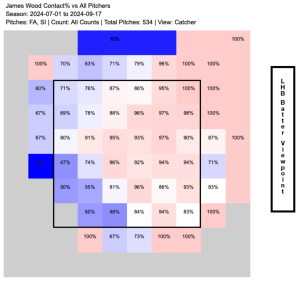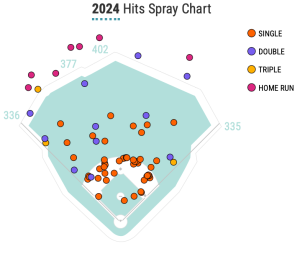It is the dawn of a new era for the Washington Nationals organization. Just over two years since the Juan Soto trade sent the club fully into rebuild mode, the Nationals’ young core is beginning to make an impact at the Major League level and the team is poised to compete for a postseason appearance in 2025. CJ Abrams and Luís Garcia Jr. have taken a step forward offensively, MacKenzie Gore flashed his potential during the first half of the season, and the long-awaited debut of Dylan Crews have all been highlights of the Nationals’ 2024 season. Perhaps the most heralded event of the season has been the arrival of top prospect James Wood to the Major League level. Acquired as one of the prospects included in the Juan Soto, Wood has top-of-the-scale power potential and is projected to be a dominant force in the Nationals lineup for years to come. This article will dive into some of the strengths and weaknesses of Wood’s profile that he has displayed this season, in an attempt to get a better understanding of his ceiling moving forward.
Quality of Contact + Contact Ability
The most impressive element of Wood’s offensive profile is the loud quality of contact that he possesses. Standing at 6’7″, 240 pounds, Wood has the presence in the batter’s box that can give opposing pitchers nightmares about his ability to hit for power, and this impression by his scouting grades as a prospect, with FanGraphs grading Wood’s raw power as a 70/80. These observations have been backed up by his batted ball metrics, with Wood producing hard hit and barrel rates consistent with some of the best hitters in Major League Baseball over the past season.
As shown by the table above, Wood has done nothing but hit the ball hard this season. In AAA, Wood produced a 60.5% hard-hit rate and 10.2% barrel rate over 149 batted ball events, while at the Major League level, Wood has produced a 50.3% hard-hit rate and 10.1% barrel rate over 169 batted ball events. Not only does this excellent quality of contact allow for Wood to hit more home runs, but it also allows for more of his batted balls to result in base hits. Wood’s ability to hit the ball hard is driven by his plus bat speed, as his average bat speed of 73.9 MPH is well above league average, allowing him to consistently produce ideal batted ball metrics.
Wood has also displayed a selective eye at the plate during his initial stint at the Major League level. Over 288 plate appearances so far this season at the Major League level, Wood has displayed a 21.6% O-Swing and 38.2% swing rate, theoretically allowing him to focus on swinging at pitches that he knows he can drive to effectively tap into his raw power. A 38.2% swing rate is bordering on passive, and might make it easier for pitchers to generate called strikes and get ahead in counts (resulting in higher strikeout rates for Wood), however, Wood has displayed higher swing rates in the Minors (26.1% O-Swing and 42.1% swing rate at AAA this season) so I would expect for Wood to increase his aggression at the plate once he gets fully adjusted to Major League pitching. As a side note, many prospects experience the opposite effect and “press” at the plate by swinging too aggressively upon promotion to the Majors and analyzing the adjustments that Wood makes to his swing tendencies will be an interesting case study to determine whether it is easier to adjust from swinging too much or too little.
One element of Wood’s offensive approach that has improved significantly this season is his bat-to-ball ability. Entering the season, Wood’s hit tool was graded as a 30/40 by FanGraphs, indicating that his present-day bat-to-ball ability was two standard deviations below the Major League average, and a 30-grade hit tool roughly translates to a 35% strikeout rate at the Major League level. After displaying a combined 13.4% swinging strike rate between stints at A+ and AA last season, Wood lowered his swinging strike rate to 10.7% at AAA and has maintained a 10.4% swinging strike rate during his stint at the Major League level this season. This sustained improvement in bat-to-ball ability provides confidence that Wood will be able to tap into his raw power in-game, and it is increasingly likely that Wood will possess closer to a 40-grade hit tool than a 30-grade hit tool over the course of his career.

One particularly impressive facet of Wood’s improved bat-to-ball ability is his tendency to consistently make contact on fastballs located on the inner third of the plate. Standing 6’7″, this is a part of the zone that tall hitters such as Wood are not expected to be able to cover effectively, as Wood’s long arms require his body to take longer to adjust his posture to make efficient contact compared to an average-sized hitter. The ability to cover this part of the zone with such long levers is typically what separates tall hitters who can tap into their massive raw power (ex. Aaron Judge), and those who experience so much swing-and-miss that they are not able to produce enough offensively to remain at the Major League level (ex. Aristides Aquino). Overall, Wood’s improved ability to make contact that he has displayed this season has been a promising development and raises his already lofty ceiling as a force in the Nationals lineup for the foreseeable future.
Batted Ball Profile
A weakness in Wood’s offensive profile this season has been his batted ball profile, particularly the spray direction of his batted balls. As mentioned in the previous paragraph, Wood displays elite raw power which allows him to hit the ball for power to all fields, however, his inability to pull the ball in the air so far this season has put a limit on the amount of offensive production he has been able to generate early in his Major League career.
As shown by the table above, Wood displayed a combined 36.3% fly ball rate and 41.2% pull rate during his stints at A+ and AA last season. This season, Wood’s fly ball rate and pull rate have significantly declined, with Wood producing an 18.4% fly ball rate and 39.1% pull rate during his tenure at AAA, and a 19.9% fly ball rate and 28.5% pull rate at the Major League level this season. Being able to pull the ball in the air is an important skill for any hitter, as this is the batted ball profile that typically results in the most power production. During his stint in Washington this season, Wood has produced a pulled fly ball rate of only 1.2%.

This phenomenon can be easily visualized by taking a look at Wood’s batted ball plot on Baseball Savant. As shown by the plot above, only one of Wood’s home runs at the Major League level this season has been to the pull side, while the other four have been hit to the opposite field. While Wood possesses the raw power necessary to be able to hit home runs to the opposite field, pulled fly balls are typically a hitter’s primary source of in-game power production. A sub-20% fly ball is well below league average (league average is ~38%), and while Wood’s raw power will allow for his batted balls to fall for base hits, the lack of loft will prevent Wood from actualizing his power potential.
I wonder if a trade-off has been made with Wood sacrificing in-game power in exchange for improved contact ability. As mentioned in the previous section, Wood has made a significant improvement regarding his bat-to-ball ability this season, and it is noteworthy that Wood’s tendency to frequently hit the ball on the ground began once his swinging strike rate began to decline. Perhaps the Nationals instilled a mental cue in Wood to try and hit the ball the other way to shorten his swing, resulting in more contact at the expense of power production. This approach could be more fully examined with the use of more bat tracking metrics, such as contact point, and it is a reasonable assumption that Wood has a deeper contact point than most of his peers, resulting in more opposite field contact and less pull-side power.
While this might be a good approach to utilize with a player with limited power potential, my opinion is that it is an inefficient utilization of Wood’s physical capabilities to prioritize him making contact over lifting and pulling the ball in the air. Over the upcoming offseason, Wood should focus on trying to pull the ball in the air more frequently (most likely by improving his point of contact) with the intent to increase his power production, and if he can improve his batted ball profile while maintaining his improved bat-to-ball ability, then Wood’s potential might be greater than what was projected before the season.
Concluding Thoughts
James Wood has top-of-the-scale power potential and is projected to be a dominant force in the Nationals lineup for years to come. While he has demonstrated an improved ability to make contact this season, Wood needs to make an adjustment to lift the ball in the air more frequently to reach his lofty offensive ceiling. In addition to his offensive potential, Wood is also a solid defender, with some analysts arguing that he could play center field at the Major League level, however, the presence of Jacob Young and Dylan Crews in Washington makes it likely that Wood will play in a corner outfield position for the foreseeable future. In conclusion, Wood’s development will be crucial to watch as the Nationals make their way out of their rebuild. If he can combine his improved contact skills with a more optimal batted ball profile, Wood has the potential to become both a cornerstone player for Washington’s next contending team, as well as one of the best outfielders in the National League.
Photo by Mark Goldman/Icon Sportswire | Featured Image by Justin Redler (@reldernitsuj on Twitter)
